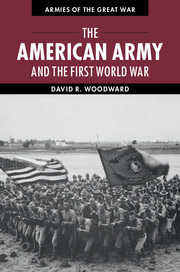Book contents
- Frontmatter
- Dedication
- Contents
- List of figures
- List of maps
- List of tables
- Preface
- List of abbreviations
- Introduction
- 1 Birth of a modern army
- 2 World war and American preparedness
- 3 Coercive power and Wilsonian diplomacy
- 4 “You’re in the army now”
- 5 US army doctrine and industrialized trench warfare
- 6 Over where?
- 7 American Expeditionary Force organization, overseas training, and deployment
- 8 Will the Americans arrive in time?
- 9 Failed expectations: “the military establishment of the United States has fallen down”
- 10 Atlantic ferry
- 11 Neck of the bottle
- 12 Uncertain times
- 13 Cantigny
- 14 Into the breach
- 15 American soldiers in north Russia and Siberia
- 16 The beginning of the end
- 17 Establishment of the American First Army and Saint-Mihiel
- 18 Meuse-Argonne, September 26–October 31
- 19 Breakout, November 1–11
- 20 Epilogue
- Notes
- Bibliography
- Index
5 - US army doctrine and industrialized trench warfare
Published online by Cambridge University Press: 05 July 2014
- Frontmatter
- Dedication
- Contents
- List of figures
- List of maps
- List of tables
- Preface
- List of abbreviations
- Introduction
- 1 Birth of a modern army
- 2 World war and American preparedness
- 3 Coercive power and Wilsonian diplomacy
- 4 “You’re in the army now”
- 5 US army doctrine and industrialized trench warfare
- 6 Over where?
- 7 American Expeditionary Force organization, overseas training, and deployment
- 8 Will the Americans arrive in time?
- 9 Failed expectations: “the military establishment of the United States has fallen down”
- 10 Atlantic ferry
- 11 Neck of the bottle
- 12 Uncertain times
- 13 Cantigny
- 14 Into the breach
- 15 American soldiers in north Russia and Siberia
- 16 The beginning of the end
- 17 Establishment of the American First Army and Saint-Mihiel
- 18 Meuse-Argonne, September 26–October 31
- 19 Breakout, November 1–11
- 20 Epilogue
- Notes
- Bibliography
- Index
Summary
With only some 6,000 officers in the Regular Army when the United States became a belligerent, the army did not have nearly enough officers or non-commissioned officers (even when National Guard officers were included) to train the masses of men arriving at training camps. An army of 1 million men needed at least 50,000 officers. To meet this need, the War Department established officer training camps. The originally required four months of training was quickly reduced to three months, resulting in “ninety-day wonders,” as some lieutenants were called. Officer training camp graduates, however, learned little of modern warfare, especially as it was being waged in the trenches in France with machine guns, grenades, automatic weapons, chemical warfare, and mortars as well as aircraft and tanks.
France and Great Britain sought to educate Americans about modern warfare by dispatching experienced soldiers to assist in specialist training. The French dispatched 286 officers; and the British sent over a further 261 officers and 226 non-commissioned officers. Although these officers were veterans there were not nearly enough of them to prepare adequately America’s youth for what lay ahead. When these foreign officers began arriving at US training camps many of them were shocked by what they encountered. Lieutenant-Colonel Gilbert W. Hall, a machine gun specialist, had been sent over from Britain in October 1917. He served as an instructor with the 89th Infantry Division, composed of draftees from Arizona, Colorado, Kansas, Missouri, New Mexico, Nebraska, and South Dakota, at Camp Funston, Kansas. “We could see almost at a glance that after having been at war for nine months, the men were poorly clothed and very poorly equipped, if it could be said that they were equipped at all,” he noted. “No rifles had been issued, Wooden guns were being used, making the instruction of an infantryman in musketry almost impossible. For drill purposes the men wore blue overalls, all had hats, poor boots, good underwear. The machine gunners had old and obsolete Colt guns which could never be used with ammunition with any degree of safety.”
- Type
- Chapter
- Information
- The American Army and the First World War , pp. 73 - 84Publisher: Cambridge University PressPrint publication year: 2014



